Whether you’re hosting a party at home, spending the day at the beach or traveling to your favorite vacation spot it’s time to select some fabulous Fourth of July wines!
Since Summer celebrations often involve groups of friends and family, opt for wines that are refreshing and delicious that won’t break the bank. Lets face it, it’s hard to contemplate an aged Bordeaux while tending to burgers and dogs on the grill AND supervising kids doing cannonballs into the pool! From a lively, Italian sparkler to a juicy, Australian red, here are five fabulous Fourth of July wines for $15 or less:
 Mionetto Prosecco Brut, Treviso, Italy NV ($12): This Italian sparkler is made from 100% Glera grapes using the Charmat Method. This method allows winemakers to produce a delicious sparkling wine without the hefty price tag. Fermentation in stainless steel preserves its fresh, fruity notes of citrus, pear and green apple and crisp, dry finish. Prosecco is the perfect sparkler to enjoy on its own as an aperitif, or as a nice complement to a variety of Summer fare. It is best enjoyed fresh and young and will not benefit from additional aging. It’s also the perfect sparkling wine to use as a base for Mimosas, Bellinis or other sparkling wine-based cocktails like our Fourth of July Pomegranate-Aperol Royale!
Mionetto Prosecco Brut, Treviso, Italy NV ($12): This Italian sparkler is made from 100% Glera grapes using the Charmat Method. This method allows winemakers to produce a delicious sparkling wine without the hefty price tag. Fermentation in stainless steel preserves its fresh, fruity notes of citrus, pear and green apple and crisp, dry finish. Prosecco is the perfect sparkler to enjoy on its own as an aperitif, or as a nice complement to a variety of Summer fare. It is best enjoyed fresh and young and will not benefit from additional aging. It’s also the perfect sparkling wine to use as a base for Mimosas, Bellinis or other sparkling wine-based cocktails like our Fourth of July Pomegranate-Aperol Royale!
Mason Cellars Pomelo Sauvignon Blanc, California, 2014 ($12): From Sancerre to White Bordeaux, Sauvignon Blanc is one of our Summer staples due to its crisp, refreshing nature and Summery citrus notes. So we were happy to discover Mason Cellar’s Pomelo Sauvignon Blanc – a delightful wine at an amazing price! The high elevation of the Mason Vineyard in Lake County’s Kelsey Bench and arc of rich, red volcanic soils, provides a unique growing region for ripe Sauvignon Blanc year after year. This wine opens with aromas of fragrant orange blossom, ruby grapefruit and white peach. On the palate, notes of lime zest and passion fruit really pop. As if that weren’t enough, this humble little Sauvignon Blanc came in at number forty on Wine Spectator’s 2015 Wines of the Year!
White Bordeaux, Sauvignon Blanc is one of our Summer staples due to its crisp, refreshing nature and Summery citrus notes. So we were happy to discover Mason Cellar’s Pomelo Sauvignon Blanc – a delightful wine at an amazing price! The high elevation of the Mason Vineyard in Lake County’s Kelsey Bench and arc of rich, red volcanic soils, provides a unique growing region for ripe Sauvignon Blanc year after year. This wine opens with aromas of fragrant orange blossom, ruby grapefruit and white peach. On the palate, notes of lime zest and passion fruit really pop. As if that weren’t enough, this humble little Sauvignon Blanc came in at number forty on Wine Spectator’s 2015 Wines of the Year!
 Kim Crawford Unoaked Chardonnay, Marlborough, New Zealand ($15): Since oak adds weight and flavors of baking spices to wine, we mainly indulge in oaked wines in the Fall and Winter months. UN-oaked Chardonnay on the other hand, is light, crisp and fruity and perfect for Summer! The grapes for this Chardonnay from Kim Crawford are from selected vineyards in Marlborough and Hawke’s Bay on the East Coast of New Zealand. The grapes were allowed to attain maximum ripeness and picked at just the right time to create a lovely, fruit-driven wine with notes of stone fruit and pear, coupled with delightful citrus character. A secondary malolactic fermentation also imparts a generous mouthfeel that will still appeal to Chardonnay lovers.
Kim Crawford Unoaked Chardonnay, Marlborough, New Zealand ($15): Since oak adds weight and flavors of baking spices to wine, we mainly indulge in oaked wines in the Fall and Winter months. UN-oaked Chardonnay on the other hand, is light, crisp and fruity and perfect for Summer! The grapes for this Chardonnay from Kim Crawford are from selected vineyards in Marlborough and Hawke’s Bay on the East Coast of New Zealand. The grapes were allowed to attain maximum ripeness and picked at just the right time to create a lovely, fruit-driven wine with notes of stone fruit and pear, coupled with delightful citrus character. A secondary malolactic fermentation also imparts a generous mouthfeel that will still appeal to Chardonnay lovers.
Bodegas Juan Gil Monastrell, Jumilla, Spain ($14): Spain is a wonderful place to  discover amazing value wines. While you may be familiar with Rioja and Ribera del Duero, a region called Jumilla is also home to many vinous gems like this one from Bodegas Juan Gil. This wine is made primarily from Monastrell (aka Mourvèdre and Mataró), a red wine grape that was harvested from very old vines. Chalky, rocky limestone soils that are poor in nutrients make the vineyard ideal for growing Monastrell. This wine was aged in French oak for 12 months. The result is a wine with a deep, purplish-black color and heady aromas of ripe currant, red berries and smoke. Rich, juicy flavors of crème de cassis and blackberry persist on the palate along with supple, ripe tannins.
discover amazing value wines. While you may be familiar with Rioja and Ribera del Duero, a region called Jumilla is also home to many vinous gems like this one from Bodegas Juan Gil. This wine is made primarily from Monastrell (aka Mourvèdre and Mataró), a red wine grape that was harvested from very old vines. Chalky, rocky limestone soils that are poor in nutrients make the vineyard ideal for growing Monastrell. This wine was aged in French oak for 12 months. The result is a wine with a deep, purplish-black color and heady aromas of ripe currant, red berries and smoke. Rich, juicy flavors of crème de cassis and blackberry persist on the palate along with supple, ripe tannins.
 Ravoire & Fils Domaine Fontanyl Côtes de Provence Rosé, Provence, France ($15): If there is ONE wine you should stock your fridge with this Summer it’s rosé. No, I’m not crazy and I haven’t been drinking. Ok, maybe I’ve been drinking, but you need to trust me here! Provence is the birthplace of dry rosé which should NEVER be confused with White Zinfandel, a purely American invention known for its poor quality (read more here). This bottle from Domaine Fontanyl is made from a blend of grapes (i.e. Cinsault, Grenache, Tibouren). It gets its color from the juice remaining in contact with the skins for a few hours to impart its glorious, hallmark rose-gold hue. This wine has notes of cherries and red berries and is incredibly food friendly. So if you haven’t already, please take a chance on rosé this Summer. I promise you’ll be glad you did!
Ravoire & Fils Domaine Fontanyl Côtes de Provence Rosé, Provence, France ($15): If there is ONE wine you should stock your fridge with this Summer it’s rosé. No, I’m not crazy and I haven’t been drinking. Ok, maybe I’ve been drinking, but you need to trust me here! Provence is the birthplace of dry rosé which should NEVER be confused with White Zinfandel, a purely American invention known for its poor quality (read more here). This bottle from Domaine Fontanyl is made from a blend of grapes (i.e. Cinsault, Grenache, Tibouren). It gets its color from the juice remaining in contact with the skins for a few hours to impart its glorious, hallmark rose-gold hue. This wine has notes of cherries and red berries and is incredibly food friendly. So if you haven’t already, please take a chance on rosé this Summer. I promise you’ll be glad you did!
Yalumba “Y Series” Shiraz-Viognier, South Australia, Australia ($14): We love Shiraz’s  juicy lusciousness for Summer and this wine makes us like it even more! The addition of Viognier, a fruity white grape, tames the wine’s tannins and imparts beautiful, floral aromatics while accentuating the wine’s fruit flavors. The practice of blending Shiraz (aka Syrah) and Viognier dates back hundred of years in France’s Northern Rhone wine region and is nicely represented by this Australian gem. Yalumba’s Y Series offers wonderful value wines for those who adore Australia’s bounty of delicious wines. This medum-bodied red is a deep crimson in color with notes of violet, plum, blueberry and dark cherry as well as plush tannins and a delightful finish.
juicy lusciousness for Summer and this wine makes us like it even more! The addition of Viognier, a fruity white grape, tames the wine’s tannins and imparts beautiful, floral aromatics while accentuating the wine’s fruit flavors. The practice of blending Shiraz (aka Syrah) and Viognier dates back hundred of years in France’s Northern Rhone wine region and is nicely represented by this Australian gem. Yalumba’s Y Series offers wonderful value wines for those who adore Australia’s bounty of delicious wines. This medum-bodied red is a deep crimson in color with notes of violet, plum, blueberry and dark cherry as well as plush tannins and a delightful finish.
We hope you enjoy our Fourth of July wines all Summer long! Have a happy and safe holiday weekend!
Cheers,
![]()
The post Red, White & Bubbles: 5 Fabulous Fourth of July Wines! appeared first on The Glamorous Gourmet.
Our latest Wine Word of the Week is phylloxera, a big word that refers to a tiny, sap-sucking root louse that loves to feast on the roots of vitis vinifera grapevines. By feeding on the grapevine however, the flow of nutrients to the plant is cut off, causing it to eventually die. Since the 1800's, phylloxera's predilection for these "vinifera" vines, which produce such well known wines as Cabernet Sauvignon and Chardonnay, has had a devastating impact on the history of the world's fine wine industry.Phylloxera was introduced to the vineyards of Europe in the mid 1800's when two English botanists unknowingly brought back infected vine cuttings from America. Since the pesky louse originated in America, indigenous grapevines were naturally resistant. However, Europe's vinifera vines had no natural protection and an epidemic quickly took hold. The first signs of infestation manifested in France's Southern Rhone in 1863. The louse subsequently spread like wildfire and, by the late 1800's, almost 90% of Europe's vineyards and it's grape growing industry had effectively been destroyed. Ironically, the source of the problem also turned out to be its salvation. After experimenting with a few different methods, it turned out that grafting vinifera vines onto naturally resistant, American rootstocks was the best way to combat the scourge of phylloxera. Thankfully, the resistant rootstocks offered protection without affecting the taste or development of the vinifera grapes as other experimental methods had. Phylloxera also had a significant impact on the vineyards of California where it also became important to graft vines onto the most resistant rootstocks available. While the debate continues as to which rootstocks are most ideal, the practice of grafting continues to this day.While phylloxera has found its way into most wine regions of the world, a few have managed to remain untouched. These include Chile, due to its geographic isolation; the island of Santorini in Greece because of its sandy, ashy soils which the phylloxera louse hates; and most of the continent of Australia. Needless to say, these regions continue to be vigilant about preventing this pest from infesting their grapevines.I hope you enjoyed our latest Wine Word of the Week! To see previous installments, please click here. If there’s a wine word you’d like to learn more about, please leave it in the comment section below!Cheers,
Ironically, the source of the problem also turned out to be its salvation. After experimenting with a few different methods, it turned out that grafting vinifera vines onto naturally resistant, American rootstocks was the best way to combat the scourge of phylloxera. Thankfully, the resistant rootstocks offered protection without affecting the taste or development of the vinifera grapes as other experimental methods had. Phylloxera also had a significant impact on the vineyards of California where it also became important to graft vines onto the most resistant rootstocks available. While the debate continues as to which rootstocks are most ideal, the practice of grafting continues to this day.While phylloxera has found its way into most wine regions of the world, a few have managed to remain untouched. These include Chile, due to its geographic isolation; the island of Santorini in Greece because of its sandy, ashy soils which the phylloxera louse hates; and most of the continent of Australia. Needless to say, these regions continue to be vigilant about preventing this pest from infesting their grapevines.I hope you enjoyed our latest Wine Word of the Week! To see previous installments, please click here. If there’s a wine word you’d like to learn more about, please leave it in the comment section below!Cheers,
Our latest Wine Word of the Week is phylloxera, a big word that refers to a tiny, sap-sucking root louse that loves to feast on the roots of vitis vinifera grapevines. By feeding on the grapevine however, the flow of nutrients to the plant is cut off, causing it to eventually die. Since the 1800’s, phylloxera’s predilection for these “vinifera” vines, which produce such well known wines as Cabernet Sauvignon and Chardonnay, has had a devastating impact on the history of the world’s fine wine industry.
Phylloxera was introduced to the vineyards of Europe in the mid 1800’s when two English botanists unknowingly brought back infected vine cuttings from America. Since the pesky louse originated in America, indigenous grapevines were naturally resistant. However, Europe’s vinifera vines had no natural protection and an epidemic quickly took hold. The first signs of infestation manifested in France’s Southern Rhone in 1863. The louse subsequently spread like wildfire and, by the late 1800’s, almost 90% of Europe’s vineyards and it’s grape growing industry had effectively been destroyed.

Ironically, the source of the problem also turned out to be its salvation. After experimenting with a few different methods, it turned out that grafting vinifera vines onto naturally resistant, American rootstocks was the best way to combat the scourge of phylloxera. Thankfully, the resistant rootstocks offered protection without affecting the taste or development of the vinifera grapes as other experimental methods had. Phylloxera also had a significant impact on the vineyards of California where it also became important to graft vines onto the most resistant rootstocks available. While the debate continues as to which rootstocks are most ideal, the practice of grafting continues to this day.
While phylloxera has found its way into most wine regions of the world, a few have managed to remain untouched. These include Chile, due to its geographic isolation; the island of Santorini in Greece because of its sandy, ashy soils which the phylloxera louse hates; and most of the continent of Australia. Needless to say, these regions continue to be vigilant about preventing this pest from infesting their grapevines.
I hope you enjoyed our latest Wine Word of the Week! To see previous installments, please click here. If there’s a wine word you’d like to learn more about, please leave it in the comment section below!
Cheers,
![]()
The post Wine Word of the Week: “Phylloxera” appeared first on The Glamorous Gourmet.
Whether Pop prefers liquor, wine or beer here are some fabulous boozy Father's Day gift ideas sure to put a smile on his face:1.) The Classic MANhattan: Dazzle Dad this Father's Day with this manly, classic cocktail. Invented in Manhattan in the late 1800's, this eponymous and utterly delicious drink only calls for three ingredients: American whiskey, Italian sweet vermouth and Angostura bitters. While a variety of whiskeys can be used including rye, bourbon and Canadian whiskey, we prefer Woodford Reserve Kentucky Bourbon. Serve the Manhattan in a cocktail glass, garnished with a Maraschino cherry. While you can definitely use the bright, neon pink version, we really love the Luxardo Original Maraschino Cherries. These sweet, tart marasca cherries from Italy's Veneto region are truly decadent and delicious! A Manhattan can also be served on the rocks in a lowball glass so whichever way Dad prefers is just fine. The Classic Father's Day MANhattan Recipe Type: Cocktail Author: Serves: 2 drinks This incarnation calls for Woodford Reserve Kentucky Bourbon and is garnished with Luxardo Maraschino cherries! Ingredients
2.) California Cabernets: Does your Dad adore wine but you're not exactly sure where to begin selecting a bottle? Thankfully, California is well known for producing world class examples of this age-worthy, delicious grape. Here are four California Cabs we love from some of Napa's most well-respected Dads:- Duckhorn Decoy Cabernet Sauvignon, Napa, California, 2014 ($25): A blend of 90% Cabernet Sauvignon and 10% Merlot, this Cab was aged for 10 Months in 100% French oak, 40% new oak and 60% neutral. It has a deep ruby and violet hue and enticing, fruit-forward aromas of blackberry, currant and black cherry. On the palate, the lush fruit is balanced by smooth, rich tannins and lovely layers of spice, cocoa and hints of toasty French oak.- Honig Cabernet Sauvignon Blanc, Napa, California, 2013 ($38): This wine is a blend of 87% Cabernet Sauvignon, 9.5% Petit Verdot, 3% Cabernet Franc and .5% Merlot aged for 18 months in American oak barrels, 35% new. The result is a big, bold Cabernet with balance, finesse and notes of black fruit, baking spices, black cherry, spices and anise, layered with toasty oak. The finish is long and lingering, with just the right amount of tannin.- Frank Family Cabernet Sauvignon, Napa, California, 2013 ($50): A blend of 80% Cabernet Sauvignon, 13% Merlot, 4% Cabernet Franc and 3% Petit Verdot, this wine spent 20 months in 33% new and 67% once and twice filled French oak barrels. The result is a wine with an inky, deep purple color and aromas of blackberries, bay leaf and graphite. On the palate, this wine has full-bodied flavors of cocoa-dusted dark chocolate, truffles, cloves and blackberries.- Cliff Lede Cabernet Sauvignon Stag's Leap District, Napa, California, 2013 ($70): This fabulous Cab is a blend of all 5 classic Bordeaux grape varieties: 80% Cabernet Sauvignon, 10% Petit Verdot, 6% Malbec, 2% Cabernet Franc and 2% Merlot. All grapes used to produce this wine hail from Napa's acclaimed Stags Leap district, whose unique soils are known for producing stellar examples of Cabernet Sauvignon. This full-bodied wine was aged in French oak barrels, 50% new, for 21 months resulting in an inky purple wine with enticing, fragrant aromas of violets, lavender and blackberry. On the palate, layered flavors of smoked cardamom, cinnamon, plum and black licorice are accompanied by polished tannins and the AVA's hallmark minerality. 3.) Saltwater Brewery Beers in Delray Beach, Florida: This family owned and run business has been producing a variety of delicious, hand crafted beers since opening their doors in 2013. Styles range from the delightful and citrusy Screamin' Reels IPA to the rich and decadent Sea Cow Milk Stout ($10.99/6 packs). In addition to their popular 6-packs, you can also treat Dad to a refillable "Growler to Go" ($28) which Dad can continue to refill, or a 750mL bottle of beer like their "Don't Get Confused" Belgian style Tripel ($15). If you can't decide which to get Dad why not take him to the brewery and he can decide for himself? Located in downtown Delray, you can both belly up to the bar for a tasting of their current selections.I also had the pleasure of sharing these boozy Father's Day gift ideas on WPTV Channel 5 yesterday! It's always fun hanging out with Roxanne Stein, John Favole, Hollani Davis and Glenn Glazer - please click below to view the video!Cheers,
3.) Saltwater Brewery Beers in Delray Beach, Florida: This family owned and run business has been producing a variety of delicious, hand crafted beers since opening their doors in 2013. Styles range from the delightful and citrusy Screamin' Reels IPA to the rich and decadent Sea Cow Milk Stout ($10.99/6 packs). In addition to their popular 6-packs, you can also treat Dad to a refillable "Growler to Go" ($28) which Dad can continue to refill, or a 750mL bottle of beer like their "Don't Get Confused" Belgian style Tripel ($15). If you can't decide which to get Dad why not take him to the brewery and he can decide for himself? Located in downtown Delray, you can both belly up to the bar for a tasting of their current selections.I also had the pleasure of sharing these boozy Father's Day gift ideas on WPTV Channel 5 yesterday! It's always fun hanging out with Roxanne Stein, John Favole, Hollani Davis and Glenn Glazer - please click below to view the video!Cheers,
Whether Pop prefers liquor, wine or beer here are some fabulous boozy Father’s Day gift ideas sure to put a smile on his face:
1.) The Classic MANhattan: Dazzle Dad this Father’s Day with this manly, classic cocktail. Invented in Manhattan in the late 1800’s, this eponymous and utterly delicious drink only calls for three ingredients: American whiskey, Italian sweet vermouth and Angostura bitters. While a variety of whiskeys can be used including rye, bourbon and Canadian whiskey, we prefer Woodford Reserve Kentucky Bourbon. Serve the Manhattan in a cocktail glass, garnished with a Maraschino cherry. While you can definitely use the bright, neon pink version, we really love the Luxardo Original Maraschino Cherries. These sweet, tart marasca cherries from Italy’s Veneto region are truly decadent and delicious! A Manhattan can also be served on the rocks in a lowball glass so whichever way Dad prefers is just fine.
2.) California Cabernets: Does your Dad adore wine but you’re not exactly sure where to begin selecting a bottle? Thankfully, California is well known for producing world class examples of this age-worthy, delicious grape. Here are four California Cabs we love from some of Napa’s most well-respected Dads:
– Duckhorn Decoy Cabernet Sauvignon, Napa, California, 2014 ($25): A blend of 90% Cabernet Sauvignon and 10% Merlot, this Cab was aged for 10 Months in 100% French oak, 40% new oak and 60% neutral. It has a deep ruby and violet hue and enticing, fruit-forward aromas of blackberry, currant and black cherry. On the palate, the lush fruit is balanced by smooth, rich tannins and lovely layers of spice, cocoa and hints of toasty French oak.
– Honig Cabernet Sauvignon Blanc, Napa, California, 2013 ($38): This wine is a blend of 87% Cabernet Sauvignon, 9.5% Petit Verdot, 3% Cabernet Franc and .5% Merlot aged for 18 months in American oak barrels, 35% new. The result is a big, bold Cabernet with balance, finesse and notes of black fruit, baking spices, black cherry, spices and anise, layered with toasty oak. The finish is long and lingering, with just the right amount of tannin.
– Frank Family Cabernet Sauvignon, Napa, California, 2013 ($50): A blend of 80% Cabernet Sauvignon, 13% Merlot, 4% Cabernet Franc and 3% Petit Verdot, this wine spent 20 months in 33% new and 67% once and twice filled French oak barrels. The result is a wine with an inky, deep purple color and aromas of blackberries, bay leaf and graphite. On the palate, this wine has full-bodied flavors of cocoa-dusted dark chocolate, truffles, cloves and blackberries.
– Cliff Lede Cabernet Sauvignon Stag’s Leap District, Napa, California, 2013 ($70): This fabulous Cab is a blend of all 5 classic Bordeaux grape varieties: 80% Cabernet Sauvignon, 10% Petit Verdot, 6% Malbec, 2% Cabernet Franc and 2% Merlot. All grapes used to produce this wine hail from Napa’s acclaimed Stags Leap district, whose unique soils are known for producing stellar examples of Cabernet Sauvignon. This full-bodied wine was aged in French oak barrels, 50% new, for 21 months resulting in an inky purple wine with enticing, fragrant aromas of violets, lavender and blackberry. On the palate, layered flavors of smoked cardamom, cinnamon, plum and black licorice are accompanied by polished tannins and the AVA’s hallmark minerality.

3.) Saltwater Brewery Beers in Delray Beach, Florida: This family owned and run business has been producing a variety of delicious, hand crafted beers since opening their doors in 2013. Styles range from the delightful and citrusy Screamin’ Reels IPA to the rich and decadent Sea Cow Milk Stout ($10.99/6 packs). In addition to their popular 6-packs, you can also treat Dad to a refillable “Growler to Go” ($28) which Dad can continue to refill, or a 750mL bottle of beer like their “Don’t Get Confused” Belgian style Tripel ($15). If you can’t decide which to get Dad why not take him to the brewery and he can decide for himself? Located in downtown Delray, you can both belly up to the bar for a tasting of their current selections.
I also had the pleasure of sharing these boozy Father’s Day gift ideas on WPTV Channel 5 yesterday! It’s always fun hanging out with Roxanne Stein, John Favole, Hollani Davis and Glenn Glazer – please click below to view the video!
Cheers,
![]()
The post Boozy Father’s Day Gift Ideas! appeared first on The Glamorous Gourmet.
Despite my passion for cooking foods of all kinds, there are a few things I've never tried to make. Simply because certain dishes, usually beloved regional specialties, require great skill, technique and time to perfect. Out of respect for those who have mastered these skills, and also a little laziness on my part, I usually only enjoy these dishes when dining out. Until recently, gnocchi was definitely on that list. Lucky for me, however, Chef Nick Morfogen of 32 East here in Delray Beach kicked off his Summer cooking class series with these iconic Italian dumplings. Over the course of the evening, he gave a whole new spin to this previously daunting dish. The demonstration-style cooking class was held in the restaurant's upstairs dining room. In addition to observing Chef's mad gnocchi skills, he also shared some insider culinary tips and tricks. First, he explained that gnocchi is not really pasta. It is more of a "dumpling" since it's made from a mixture of potatoes, eggs, flour and cheese. There are also many regional variations in Italy as well as other countries including France (gnocchis à la parisienne), Croatia (njoki) and even South America (ñoqui).
The demonstration-style cooking class was held in the restaurant's upstairs dining room. In addition to observing Chef's mad gnocchi skills, he also shared some insider culinary tips and tricks. First, he explained that gnocchi is not really pasta. It is more of a "dumpling" since it's made from a mixture of potatoes, eggs, flour and cheese. There are also many regional variations in Italy as well as other countries including France (gnocchis à la parisienne), Croatia (njoki) and even South America (ñoqui).
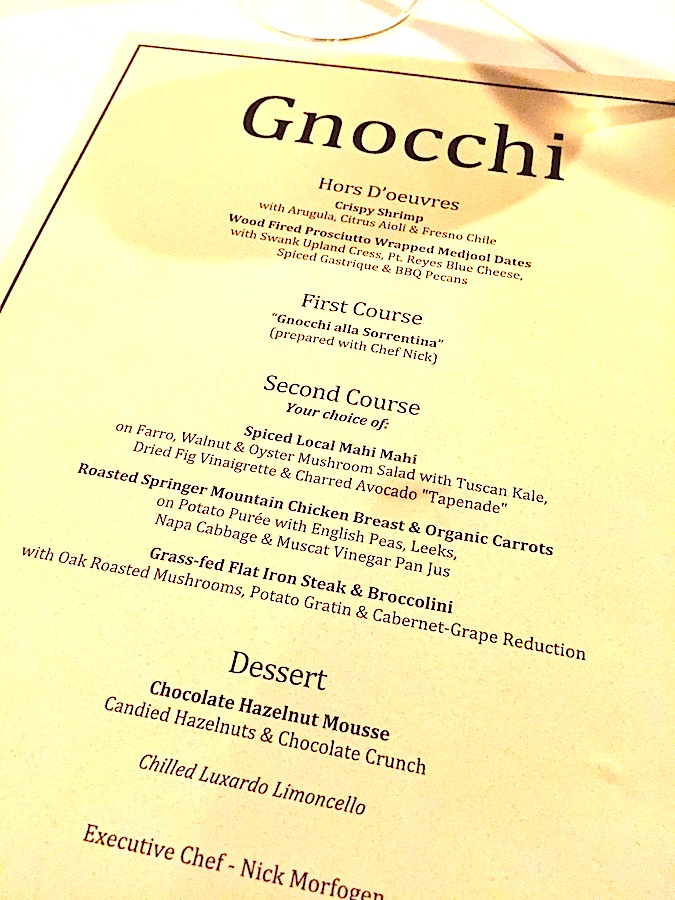 Chef also stressed the importance of using the best quality, freshest ingredients available. His favorite Parmesan cheese is the Vacche Rosse Parmigiano Reggiano. "Vacche Rosse" literally means "red cow," and refers to the special breed of Italian cow whose milk is prized for its high butterfat and protein content. The Vacche Rosse Parmigiano is also aged for a minimum of 30 months, compared to only 24 months with other Parmesans. Chef also clarified that buffalo mozzarella is a fresh cheese made from the milk of the Italian water buffalo. And much like Italian wines, certain high quality foods including these cheeses carry a DOP classification ("Denominazione di Origine Protetta," or “Protected Designation of Origin”) which ensures they are from a specific region and have met certain strict production criteria.
Chef also stressed the importance of using the best quality, freshest ingredients available. His favorite Parmesan cheese is the Vacche Rosse Parmigiano Reggiano. "Vacche Rosse" literally means "red cow," and refers to the special breed of Italian cow whose milk is prized for its high butterfat and protein content. The Vacche Rosse Parmigiano is also aged for a minimum of 30 months, compared to only 24 months with other Parmesans. Chef also clarified that buffalo mozzarella is a fresh cheese made from the milk of the Italian water buffalo. And much like Italian wines, certain high quality foods including these cheeses carry a DOP classification ("Denominazione di Origine Protetta," or “Protected Designation of Origin”) which ensures they are from a specific region and have met certain strict production criteria. Chef also suggested baking the potatoes on a bed of salt to prevent the bottoms from burning (brilliant!). After divesting the pre-baked potatoes of their skins, he deftly worked them through a food mill. This broke them up while also imparting a light, airy texture. Either a food mill or potato ricer can be used for this task and I'm a big fan of the ricer. I've used mine to make heavenly mashed potatoes for many years and I especially like this one. While incorporating the flour into the potato and egg mixture a little at a time, Chef stressed the importance of not overworking the dough. This will make it tough and could possibly ruin the finished product. Once the dough has been rolled into "ropes" and cut into the classic bite-size pieces, each gnocchi must be rolled over a "gnocchi paddle." This essential piece of equipment gives the gnocchi their hallmark, groovy appearance. At under $10, this is a worthwhile investment for the gnocchi lover.
Chef also suggested baking the potatoes on a bed of salt to prevent the bottoms from burning (brilliant!). After divesting the pre-baked potatoes of their skins, he deftly worked them through a food mill. This broke them up while also imparting a light, airy texture. Either a food mill or potato ricer can be used for this task and I'm a big fan of the ricer. I've used mine to make heavenly mashed potatoes for many years and I especially like this one. While incorporating the flour into the potato and egg mixture a little at a time, Chef stressed the importance of not overworking the dough. This will make it tough and could possibly ruin the finished product. Once the dough has been rolled into "ropes" and cut into the classic bite-size pieces, each gnocchi must be rolled over a "gnocchi paddle." This essential piece of equipment gives the gnocchi their hallmark, groovy appearance. At under $10, this is a worthwhile investment for the gnocchi lover. After boiling the gnocchi in a large pot of salted water (when they float, they're done!) our lesson was complete. We then had the pleasure of sampling Chef Nick's Gnocchi all Sorrentina. The dish featured the freshly prepared gnocchi in a flavorful marinara sauce dusted with grated Vacche Rosse Parmigiano. It was pure heaven and we enjoyed the dish with a bottle of Castello di Bossi Chianti Classico Riserva. This Sangiovese-based red wine from Tuscany paired perfectly with the gnocchi and savory red sauce.Inspired by Chef Nick's class, I recently made plans to have some friends over for gnocchi. Perfecting any recipe takes time and you have to start somewhere, right? I'll also have lots of Chianti on hand just in case.Bon appétit,
After boiling the gnocchi in a large pot of salted water (when they float, they're done!) our lesson was complete. We then had the pleasure of sampling Chef Nick's Gnocchi all Sorrentina. The dish featured the freshly prepared gnocchi in a flavorful marinara sauce dusted with grated Vacche Rosse Parmigiano. It was pure heaven and we enjoyed the dish with a bottle of Castello di Bossi Chianti Classico Riserva. This Sangiovese-based red wine from Tuscany paired perfectly with the gnocchi and savory red sauce.Inspired by Chef Nick's class, I recently made plans to have some friends over for gnocchi. Perfecting any recipe takes time and you have to start somewhere, right? I'll also have lots of Chianti on hand just in case.Bon appétit, "Chef Nick Morfogen's Potato Gnocchi"
Cuisine: Italian
Author:
"Potato Gnocchi" Author: Chef Nick Morfogen | 32 East Cuisine: Italian
Ingredients
"Chef Nick Morfogen's Potato Gnocchi"
Cuisine: Italian
Author:
"Potato Gnocchi" Author: Chef Nick Morfogen | 32 East Cuisine: Italian
Ingredients
Despite my passion for cooking foods of all kinds, there are a few things I’ve never tried to make. Simply because certain dishes, usually beloved regional specialties, require great skill, technique and time to perfect. Out of respect for those who have mastered these skills, and also a little laziness on my part, I usually only enjoy these dishes when dining out. Until recently, gnocchi was definitely on that list. Lucky for me, however, Chef Nick Morfogen of 32 East here in Delray Beach kicked off his Summer cooking class series with these iconic Italian dumplings. Over the course of the evening, he gave a whole new spin to this previously daunting dish.

The demonstration-style cooking class was held in the restaurant’s upstairs dining room. In addition to observing Chef’s mad gnocchi skills, he also shared some insider culinary tips and tricks. First, he explained that gnocchi is not really pasta. It is more of a “dumpling” since it’s made from a mixture of potatoes, eggs, flour and cheese. There are also many regional variations in Italy as well as other countries including France (gnocchis à la parisienne), Croatia (njoki) and even South America (ñoqui).

The gnocchi paddle gives these potato dumplings their hallmark, groovy appearance

Chef also stressed the importance of using the best quality, freshest ingredients available. His favorite Parmesan cheese is the Vacche Rosse Parmigiano Reggiano. “Vacche Rosse” literally means “red cow,” and refers to the special breed of Italian cow whose milk is prized for its high butterfat and protein content. The Vacche Rosse Parmigiano is also aged for a minimum of 30 months, compared to only 24 months with other Parmesans. Chef also clarified that buffalo mozzarella is a fresh cheese made from the milk of the Italian water buffalo. And much like Italian wines, certain high quality foods including these cheeses carry a DOP classification (“Denominazione di Origine Protetta,” or “Protected Designation of Origin”) which ensures they are from a specific region and have met certain strict production criteria.

Chef also suggested baking the potatoes on a bed of salt to prevent the bottoms from burning (brilliant!). After divesting the pre-baked potatoes of their skins, he deftly worked them through a food mill. This broke them up while also imparting a light, airy texture. Either a food mill or potato ricer can be used for this task and I’m a big fan of the ricer. I’ve used mine to make heavenly mashed potatoes for many years and I especially like this one. While incorporating the flour into the potato and egg mixture a little at a time, Chef stressed the importance of not overworking the dough. This will make it tough and could possibly ruin the finished product. Once the dough has been rolled into “ropes” and cut into the classic bite-size pieces, each gnocchi must be rolled over a “gnocchi paddle.” This essential piece of equipment gives the gnocchi their hallmark, groovy appearance. At under $10, this is a worthwhile investment for the gnocchi lover.

After boiling the gnocchi in a large pot of salted water (when they float, they’re done!) our lesson was complete. We then had the pleasure of sampling Chef Nick’s Gnocchi all Sorrentina. The dish featured the freshly prepared gnocchi in a flavorful marinara sauce dusted with grated Vacche Rosse Parmigiano. It was pure heaven and we enjoyed the dish with a bottle of Castello di Bossi Chianti Classico Riserva. This Sangiovese-based red wine from Tuscany paired perfectly with the gnocchi and savory red sauce.
Inspired by Chef Nick’s class, I recently made plans to have some friends over for gnocchi. Perfecting any recipe takes time and you have to start somewhere, right? I’ll also have lots of Chianti on hand just in case.
Bon appétit,
![]()
The post Gnocchi Cooking Class with Chef Nick Morfogen appeared first on The Glamorous Gourmet.